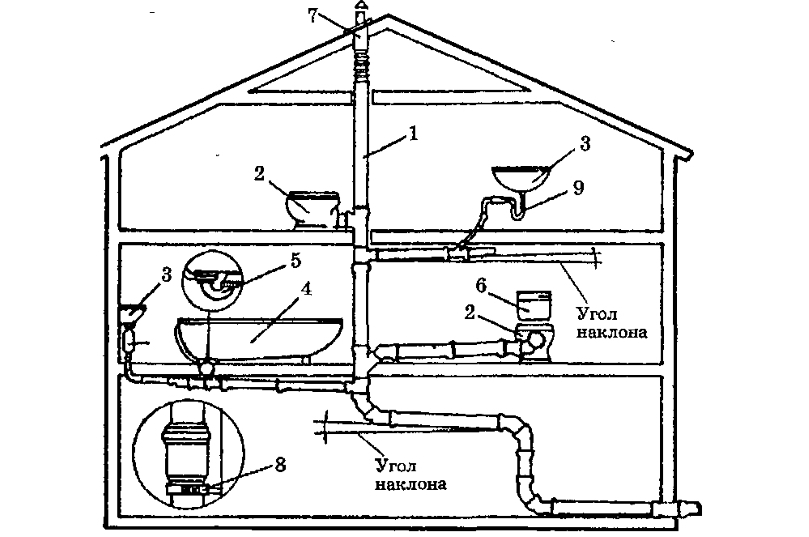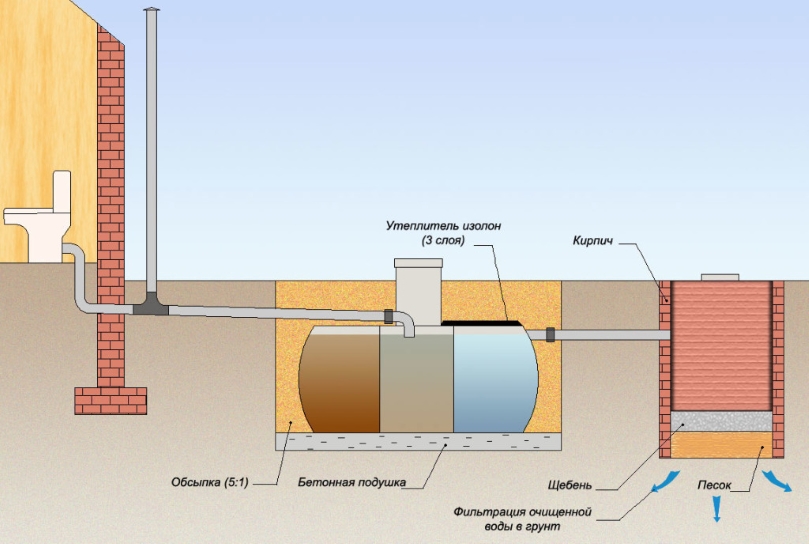Possible sewer ventilation options
The arrangement of modern private houses requires special attention even at the design stage of the building. A properly organized system for the removal and disposal of liquid household waste will free future residents from the need for additional costs for installing a septic tank.
Photo: sewer ventilation options in a private house
The most common design error is the lack of a sewer ventilation scheme. In small houses with a minimum amount of sewage, this defect will not cause inconvenience for some time. But in multi-storey buildings, in which the load on the sewer system increases significantly, an unpleasant odor appears almost immediately.
This is due to the lack of constant atmospheric pressure in the system. Liquid waste goes into the sewer under the influence of its own weight, and the resulting vacuum space is filled with air flavored with the smell of wastewater. Air masses, as they move from the cavity of the septic tank through the plumbing pipes, encounter obstacles in the form of new portions of the liquid and, passing through them, make unpleasant “champing” sounds.
Sewer ventilation is needed, even if a one-time discharge of water, with the simultaneous operation of all plumbing fixtures in the house, is not able to completely block the cross section of the sewer pipe. After the siphon dries up, which occurs during a long downtime of plumbing, an unpleasant odor freely penetrates into the room.
Types of sewer ventilation
Ventilation of the sewer system is carried out by means of fan pipes. They provide a constant supply of fresh air, regulate the internal pressure of the sewer system and draw out the smell of decaying organic matter. Depending on the scheme of their location, sewer ventilation is divided into two types: internal and external.
Internal sewer ventilation
In this case, the fan pipe is attached vertically to the riser of the sink, toilet bowl or bathtub, being, as it were, its continuation. Since such installation is possible only inside the building, the installation site is determined during the construction planning. The diameter of the ventilation pipe must be equal to the diameter of the riser, otherwise it will not be able to fully perform its functions. It is unacceptable to connect the outlet of the fan pipes to a kitchen hood, chimney or room ventilation. At the same time, it is possible to make a single ventilation system for all plumbing in the house with one exit to the street.
 Photo: general sewer ventilation scheme
Photo: general sewer ventilation scheme If the internal ventilation of the sewer in a private house is not provided for by the project, it is worth trying to bring the vent pipe through the outer wall of the building. Thus, the main part of the ventilation will be outside the building, which will save on drilling holes in the roof and eliminating the effects of mounting on the ceiling.
The height of the fan pipe above the roof level is determined by its shape. For flat roof surfaces, a pipe elevation of about 30 cm is sufficient, and for inclined roof surfaces, the length of the air intake can reach half a meter. To ensure better air removal from the sewer and prevent it from entering the dwelling, fan pipes are installed at a distance from window openings, loggias.
Care should be taken in advance to protect the ventilation outlet from precipitation and accidental ingress of foreign objects by installing a deflector at the end of the pipe. It can be purchased at a specialized store or do it yourself.
External sewer ventilation in a private house
External ventilation of a sewer septic tank in a private house can help out if no other option was provided for when planning the building. The essence of this method is to connect the drain pipe to the wastewater drainage system outside the house. There are several mounting options here:

A standard external ventilation pipe has a diameter of 11 cm, regardless of the section of plumbing pipes and the volume of the septic tank.
How to do without installing a pipe system
In cases where it is not possible to recreate a full-fledged sewer ventilation system in a private house, it will be possible to prevent the smell of sewage from entering the dwelling with the help of a ventilation valve. Its installation will not take much time, and the design does not require special knowledge and skills. You can make such a valve with your own hands from materials that are available in almost any home.
The ventilation valve will become a guaranteed protection of the room from extraneous odors, even if there is a functioning system of fan pipes, but for some reason it does not cope with its task. This is especially true in an apartment building, where the sewer ventilation scheme was agreed upon at the construction project stage and it will be problematic to make any changes to it.
How to make and install the easiest vent valve
To make a ventilation plug with your own hands, you will need:
- Plastic and foam circle, with a diameter of 5 and 6 cm, respectively;
- Self-tapping screw 4.5 cm long;
- Spring from an automatic ballpoint pen;
- Triple riser fitting cover;
- Super glue.
 Photo: homemade ventilation valve
Photo: homemade ventilation valve In the middle of the lid, it is necessary to draw an equilateral triangle with sides of 2.5 cm, the center of which is the center of the general circumference of the lid. At each vertex of the triangle, you need to drill a small hole, and pierce the central mark with an awl. Glue plastic and foam plates together.
Now you can start assembling. The spring is put on a self-tapping screw, which subsequently connects the foam and plastic plug to the tee cover.
Before installing the valve, it is worth checking its operation as follows: blow into the drilled holes and from the back of the structure. Air should easily enter from the outside of the valve and not leak from the inside. If these conditions are not met, the spring resistance should be adjusted using a self-tapping screw.
After carrying out all the tests, you can return the cover to its rightful place and not worry about an unpleasant smell in the house. Provided that the septic tank is constantly used and the plug is regularly cleaned, the valve will work normally.









